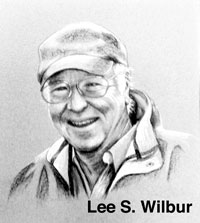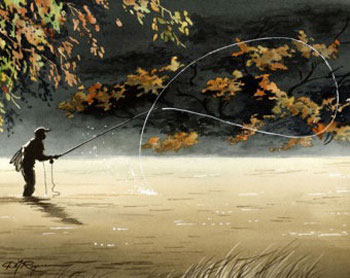Early Fishing on the St. John River,
Part 2

One of Dad’s fishing friends in Southwest Harbor was a pharmacist, Philip “Phil” Carroll owner of Carroll Drug Store there in town. I don’t recall the exact timing. Year or so after our first trip to the river, Dad helped Phil get permission to build a fishing camp on “Slidebank,” a high bluff overlooking the river. Camille, our guide, either built the camp or had a hand in overseeing the very basic construction. Rough cut boards and timbers, rolled roofing on the sides and roof, used windows. Camp was a two-room layout: kitchen “dining area” on the left facing the river and bunkroom to the right sleeping 2-4 on wooden bunks along with a couple of brass spring beds...bring your own air mattress.
Kitchen consisted of a large sink with water jug off to one side, place for pails of water and this gorgeous, or so I thought at the time, wood burning “Clarion” cook stove on or in which, some “mighty good grub” was prepared. To keep the old girl happy, out back was a kind of lean-to wood shed, fairly good size, which must have been filled by Camille in the winter. Our only wood duties were limited to splitting cedar and spruce and keeping the wood box filled. I thought it was just shy of heaven, this camping in a cabin... not having to be concerned about a wet sleeping bag if it rained. Where instant sleep arrived when one’s head hit the pillow. Course, Dad and Phil, as youngsters, knew this life from childhood. They’d grown up with wood or coal burning stoves to heat the family homes. Had to keep the wood box filled.

Fishing time for us was always end of June for several reasons. School was summer recess. Ice was finally out of the river, and later was summertime, “make a year’s pay time,” when Dad the doctor and Phil the druggist were at full steam taking care of “Summer Folks.” Several days were actually quite warm and we’d walk or drive back to camp to find the interior, shall we say, “rather steamy.” Cooking any meal meant either firing up the stove with split, dry spruce kindling (adding several degrees) or using one of the three burner Coleman gas stoves of which several in various state of repair seemed to collect as time went by.
Colemans were great, could take one along if we wanted to cook a few trout for lunch, brew a pot of tea, heat a sandwich on a cool day; however, it’s darned difficult to bake biscuits on a Coleman stove and Phil, who’d grown up on an early settled farm (Carroll’s Hill in Southwest Harbor) could bake some mean biscuits. I can see him now, opening the oven door on the cookstove after we’d stoked it as much as an hour, camp by now at least 85 degrees, sticking his hand in the oven and passing judgment whether this was “biscuit heat” or “Few more minutes. Add a couple more sticks of spruce.” More plus degrees!!
They’d grown up with
wood or coal burning stoves
to heat the family homes.
Fishing day might go something like this: Wake up to first light, lay in the rack for a bit listening to the olders snoring, tiptoe into the kitchen as I got older, fire a Coleman and start water boiling for coffee, then snare bacon from a cooler to “try” grease for fried eggs and yesterday’s trout. We had trout at least once a day, and more often than not two or three times. Were days when one or more of us would walk the few steps out to the river, “throw out a line,” and with luck we’d have fresh trout for breakfast. Knew it would be next year till “St. John Time” rolled around again.
Breakfast table was usually a time to discuss just where we’d fish that day if Camille was running the mail. We could fish in front of camp which was often a good producer, or put a canoe on whatever vehicle we had and troll for big fish on Chemquasabunticook (locally known as “Ross Lake.”) There were other good “holes” within driving or canoeing distance, all at one time or another “producers.”
Dad and Phil were both fly fishermen. Both were a pleasure to watch as they’d settle a fly by a large rock or an overhanging tree, or perhaps just downriver from a snag of trees or brush. I, on the other hand, was not a patient fisherman. Too young to have mastered the fine arts, I threw worm-gobbed hooks from an early bait casting rig of Dad’s and then later, one he had bought for my own. One of best presents I’ve ever received was invention of the spin casting reel. I could finally place the bait, no more snarls from backlash. Better than television. Whatever the choice, we all caught fish and returned many as day wore on, never keeping more than we could eat until the last few days when the coolers were filled with limits to take home. It was a treat for my mother and sister Suzanne to have a good mess of brook trout and fiddleheads when we came home, but for me, nothing would match what we’d just left on the river.

Camille, days he didn’t have to run the mail, would guide us. Take us to relatively untouched areas of the river or other streams and tributaries he knew. The St. John Rivershed is huge. Finding it’s beginnings in the little St. John Lake, East of St. Zacharie, Quebec area, continuing north to join the famed Allagash, at the northern half of the state, then over and northerly again to Madawaska then tumbling down through Grand Falls, Canada to the North Atlantic. It was, when we began fishing there, one of the greatest producers of brook trout in the world. But along with trout was another fish, a “trash fish,” hungry, and a royal pain, known by all who fished it as “chub.” Some days you could throw a line and one after another catch a deadweight chub. No fight, just reel it in and scale them up on the riverbank for something else in the food chain to eat. Stay tuned...until next month.
With summer in sighting distance, here’s a light-hearted dish to accompany those magnificent burgers or steaks from the grill.
Fair Winds and Good Roads
• R E C I P E •
Roasted Red Bell Peppers with Provolone or Feta
6 small red bell peppers
2 T olive oil, extra for oiling
3 garlic cloves, sliced thin
9 oz. provolone or feta, sliced thin
12 fresh mint leaves Grated rind and juice of one (1) lemon
1 T chopped fresh thyme
3 T pine nuts
Pepper
Cut peppers lengthwise in half and remove cores and seeds. Rub their skins with a little bit of the oil, then arrange, skin side down, on a large oiled cookie sheet. Scatter half the garlic into the peppers, add the cheese, then the mint leaves, remaining garlic, thyme, pine nuts, and pepper. Drizzle over the remaining oil and the lemon juice. Roast in a preheated oven 400 deg. for 30 minutes until tender and beginning to char around the edges. Serve warm. Bon Appetit!
